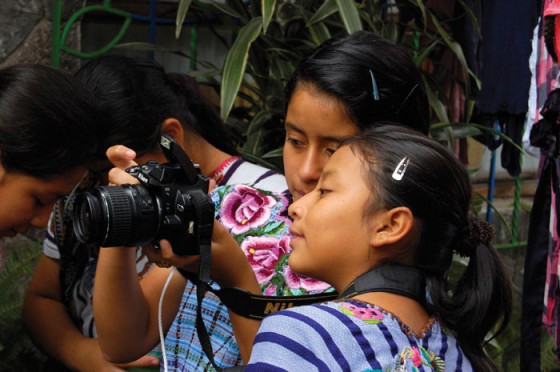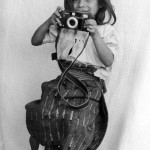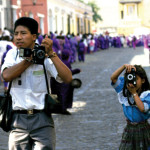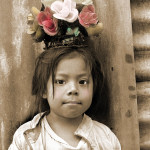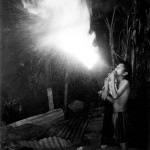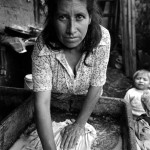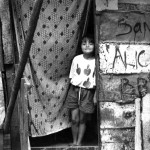Fotokids Anniversary
Twenty years of tackling poverty through photography
Surrounded by 40 acres of toxic garbage, in the middle of Central America’s largest and most dangerous landfill, isn’t exactly where most people gain inspiration. However, for ex-Reuters photojournalist Nancy McGirr, the smell of burning plastic, combined with the sight of cardboard houses and gardens of sewage, is where Fotokids first began.
Originally called “Out of the Dump,” this unique project was founded in 1991 with the aim of using photography to break the cycle of poverty, and this month the NGO celebrates its 20th anniversary.
“I first went to the dump to photograph a story for an Australian magazine,” says McGirr. “There were 3,500 people living, working and scavenging for food–and 1,500 of them were kids who followed me wanting to see through my camera lens. The thought occurred to me: If they had the camera, what would they see through that lens?”
Armed with three cheap, plastic cameras the first group of six students aged 5-12 began their enrollment process: taking photos of everything and censoring nothing. The students, who all lived in Guatemala City’s sprawling garbage dump, took pictures of whatever fell before their lens: drugs, violence, death.
McGirr soon realized their photographs could be used as a teaching tool to show them they didn’t have to be part of a gang to be in a group, and that cameras are a more effective weapon against poverty than guns.
By taking snapshots of their everyday lives, children from some of the poorest neighborhoods in the city began to express themselves. Children who, at the age of 7 had been exposed to more pain and suffering than anyone should witness in a lifetime, could start to dream.
A Dump with Travel Benefits
“I originally thought the project would last six months to a year, but it just took off,” recalls McGirr. “We started in July and by September had already appeared in The Washington Post.”
A couple of months later, Konika Japan sent supplies and asked them to exhibit in Tokyo, they were the cover story of various magazines and even had a film crew from London come out to record two TV episodes for a children’s art show.
From the initial six students who entered the after-school program, hundreds have passed through it. Each receiving a camera, food, photography classes and educational scholarships–while having their work displayed in exotic locations around the world.
From meeting the Dalai Lama, to working on the set of Star Wars: Attack of the Clones and exhibiting alongside Brazilian photographer Sebastian Salgado, Fotokids has created a future for many underprivileged children: a tool with which they can escape their lives of perpetual poverty, drugs and gang violence.
A Culture of Giving Back
“I never imagined going on a plane,” says Evelyn Mansilla, who started with Fotokids 18 years ago. “But at 15 I went to Spain, then to Australia and San Francisco.”
Mansilla, who grew up near the dump, now works as the administrative director of the project and believes the experience changed her life. “Without it I’d never have finished school, gone to university or been able to give back to my community.”
Giving back is an integral part of Fotokids’ philosophy. Many of the students become the teachers and work in the school in Zone 13 or in outreach programs across the city or farther afield in Santiago Atitlan and Honduras. The staff are all Fotokids graduates who feel compelled to give others the opportunities they have had.
Often they go back to their own communities, mentoring children and showing them what can be achieved if they work hard at school and stay in the program.
Challenges
“We all want to branch out and take the project to more places in the city. There are so many children of all ages here that need our help,” says Mansilla. “Around 7 years old is a good time to start–that’s when gangs start recruiting.”
As well as dealing with the threat of gangs, one of the main challenges Fotokids faces is persuading parents to let their children stay in the program. Parents often fail to see the long-term benefits of keeping children in school beyond sixth grade and would rather they start contributing to the family income.
To tackle this problem teachers work directly with communities, going into some of the most dangerous barrios in Guatemala City and giving classes to children while building relationships with their families.
“Of course, they don’t all go on to become photographers,” states McGirr. “Photography just gives them an identity and a platform”–for other opportunities they would never otherwise have had.
Entrance to Fotokids’ month-long “20 Years Capturing Dreams” exhibition is free and opens at 5:30pm, Thursday, August 4 at Artecentro Graciela Andrade de Paiz (9a Calle 8-54 zone 1, Guatemala City).
More information: www.fotokids.org
